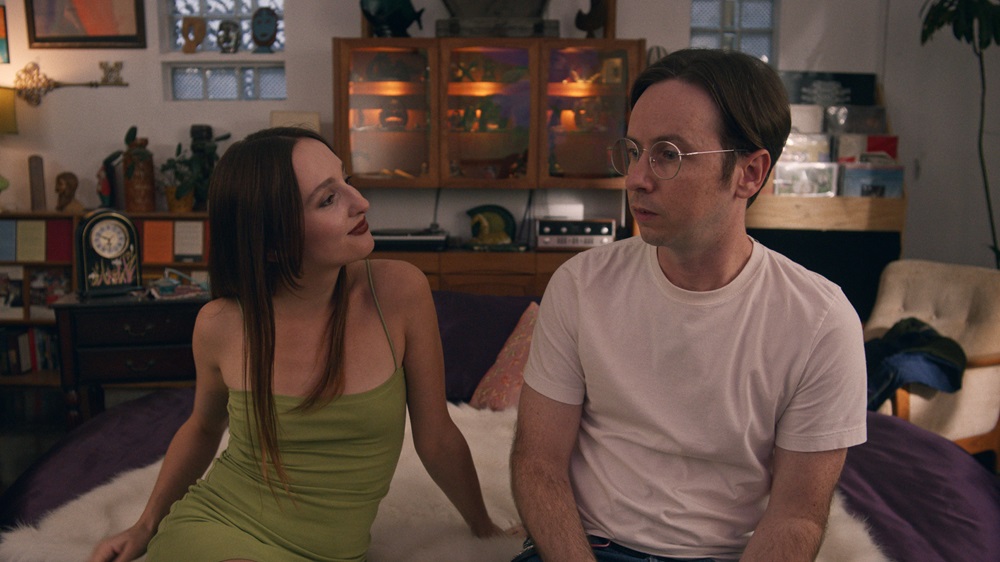Over the years, there have been several films that tackle the use of sex as a substitute for emotional connection, as well as those that focus on the transactional nature of sexual relationships. Sook-Yin Lee’s “Paying for It,” while another entry to this list of films, somehow breathes fresh air to the narrative device, and in doing so succeeds in spades.
For one, this adaptation of Chester Brown’s graphic memoir (a provocative and personal account of Brown’s experiences with paying for sex) benefits from a female perspective that the source material sorely lacked. More importantly, however, the director used to be the cartoonist’s real-life ex-partner; and since their breakup figures prominently in the story, Lee’s point of view adds more depth and dimension than what the graphic novel explored on a surface level.
Acquiescing to a Very Strange Arrangement
From the get-go, the film wordlessly provides enough context as to which stage of the relationship its two characters are already in. A messy house, a leaky faucet, a pair of toothbrushes with bristles touching each other, the snoring in bed; the scenes paint a long-term relationship that’s clearly way past the cutesy stage.
And then, the film pulls the rug from under: “Paying for It” begins with a breakup. The woman, Sonny (Emily Lê portraying Lee’s alter ego), wakes Chester (Daniel Beirne) from his sleep by saying she thinks she has fallen in love with someone else. She wants to tell Chester first before doing something about her feelings with another person.
While normally this revelation would be met negatively by a spurned lover, Chester stays rather level-headed. Both the film and the graphic novel depict a mature conversation about the breakup, with the two stating how much they love living together, and would rather keep it that way than having one of them move out. As Sonny reasons, “I guess I’m just asking for your permission to see where this goes,” to which Chester acquiesces, much to the consternation of the latter’s fellow cartoonist friends.
The early goings after the breakup, needless to say, have the making of toe-curling awkwardness. Eventually, Chester moves into the basement where he also does his cartoons. As Sonny brings in new boyfriends, he ends up forced to listen to the sounds of joy upstairs, from the playful teasing to the noises of lovemaking. Opening up to his friends about his predicament, Chester receives advice which he finds enticing: pay someone for sexual favors.
Enjoying Connections Through Sex by Paying for It
Set in the late-1990s, the film captures the sensibilities of a bygone era. Gayle Ye’s camerawork invites the viewers who were from that generation to bask in a dose of nostalgia. This, frankly, plays to the film’s strengths, as the filmmakers stayed faithful to the graphic novel. All the references scream ‘90s, with Sonny’s work as a video jockey being a nod to the heyday of music television channels like MTV. We also see Chester using a phone book to contact prostitutes that he could solicit and pay for sex.
Yes, in this case, the film’s title refers to sex. And yes, Lee depicts Chester’s first encounter with a prostitute in a way that neither indicts nor shames his exploits (or lack thereof). As he overcomes that first ‘paid’ experience, Chester happily confides in Sonny about it, reasoning that he’s “exploring new methods of intimacy.” And while she initially doesn’t support the decision, she ultimately does, creating more avenues for them to have a more open relationship.
The film jumps forward a year at a time, revealing Sonny bringing in one boyfriend after another, and Chester using the internet to search for escort services. As she ends up breaking up with her new boyfriend yet again; Chester on the other hand continues his exploration by ‘paying for it’, meeting several characters along the way. These include Anne and Amanda, as well as “Tina, Patience, Celine, Julie, Angelina, the other Angelina, and Wendy.”
Through all these, Chester and Sonny remain good friends, now engaging in candid and sometimes philosophical conversations. In a way, they are in a better relationship than they were before they broke up…until they aren’t.

A Destigmatization of Sex Work Through a Level-Headed Lens
“Paying for It” destigmatizes sex work by humanizing all those involved. Whether as a means to earn extra income, escape their hometown, or to derive some semblance of connection through it; prostitution has always remained a thorny subject. Fortunately, Lee eschews assuming the role of judge here, respecting her ex-partner’s decisions as well as maintaining equanimity in telling this complex story of attempting to find real emotional connection from something long considered superficial.
This is evident when Chester hires the services of Yulissa (“Modern Whore” author-producer Andrea Werhun), an escort who only does outcall sex work. Her culturally literate worldview runs counter to Chester’s hardened cynicism about romantic relationships. This, in turn, sparks a chemistry between them that challenges him to confront a world where he can establish genuine romance amid his newfound sexual liberation.
Moreover, Lee directs this story (from a screenplay she co-wrote with Joanne Sarazen) with the same level of honesty Brown displayed when he created the graphic novel. She doesn’t excuse herself from the pain she caused, and it comes off clear with Sonny’s failed relationships since breaking up with Chester.
What this does, as a result, is create a narrative that further improves upon the honesty of the black-and-white cartoon memoir by incorporating the point of view of the other major player in the story. Toning down the source material’s clinical approach, Lee instead chooses to infuse more backstory to Sonny’s character. This gives “Paying for It” a fuller story, with a beating heart that’s arguably missing from Brown’s work.
And you know what? It makes sense. After all, when thinking about it, it’s her story, too.